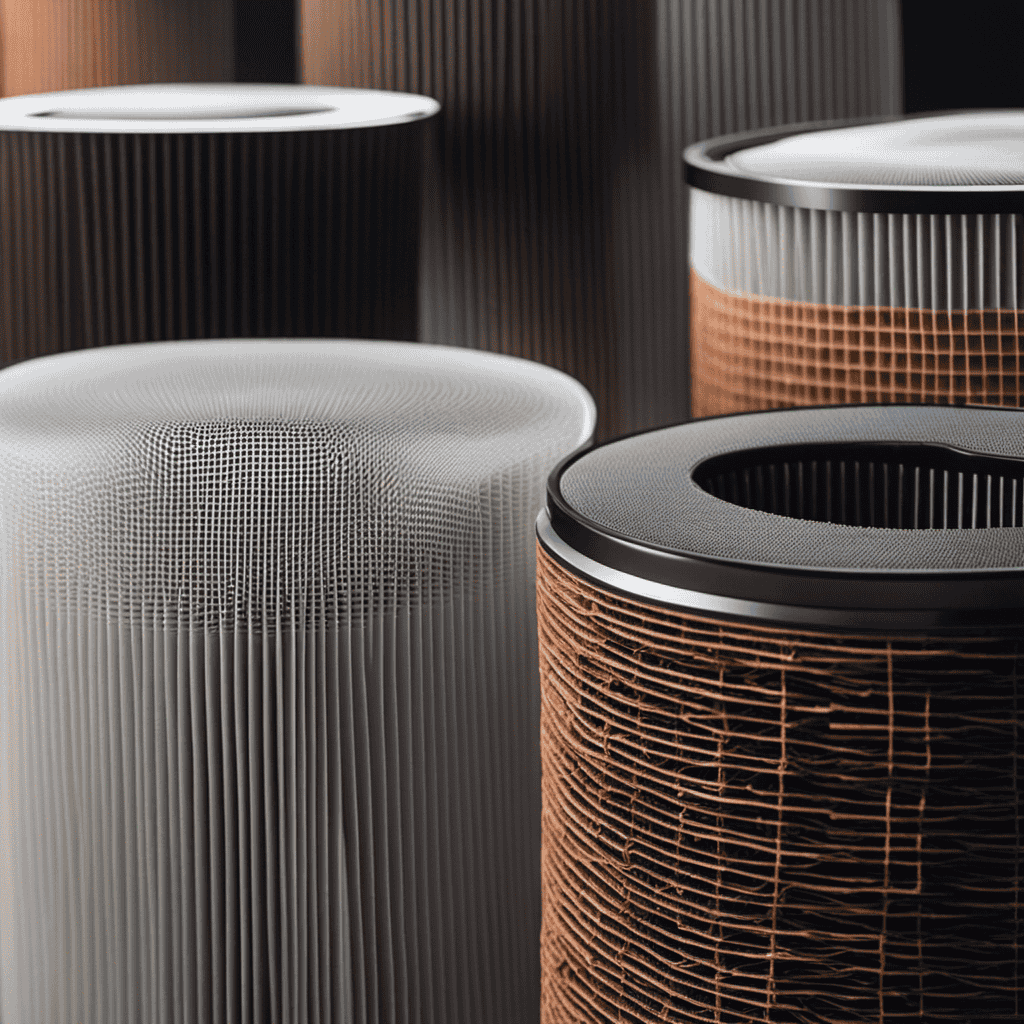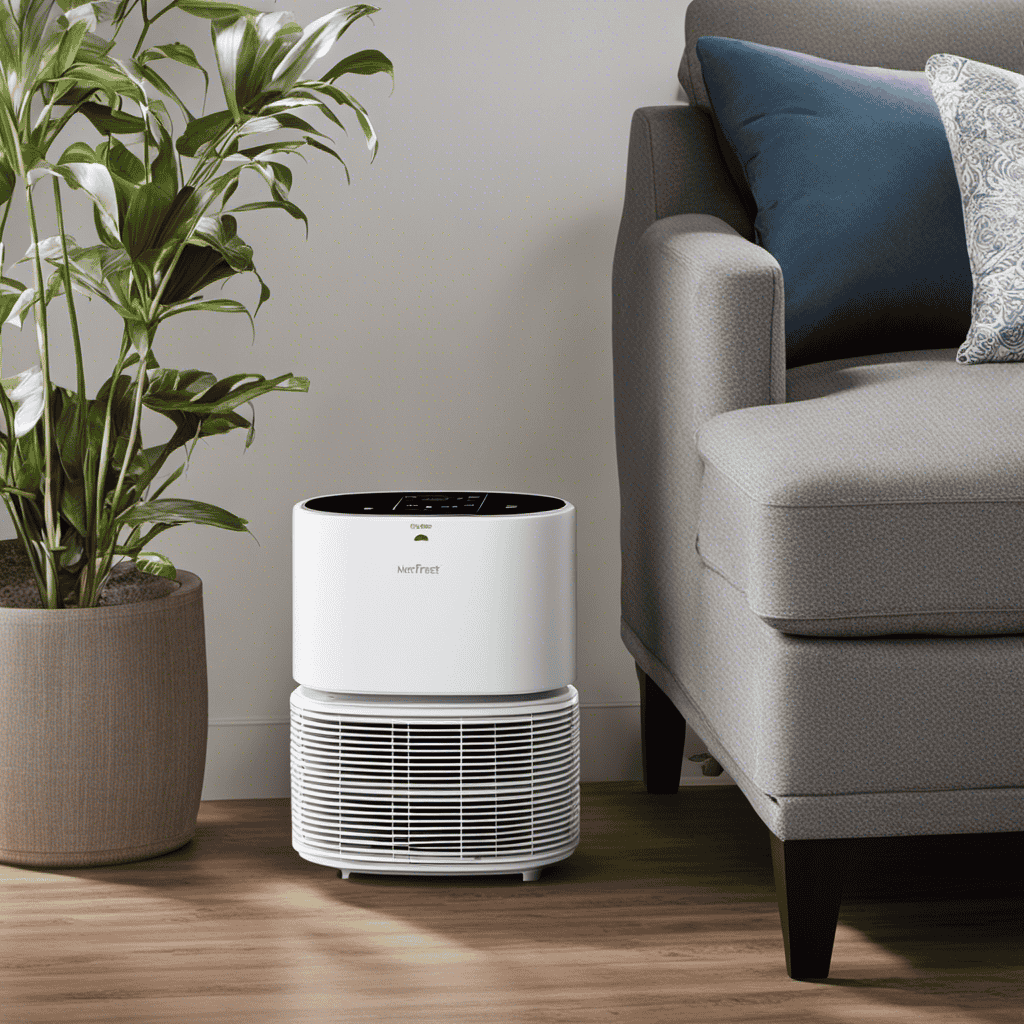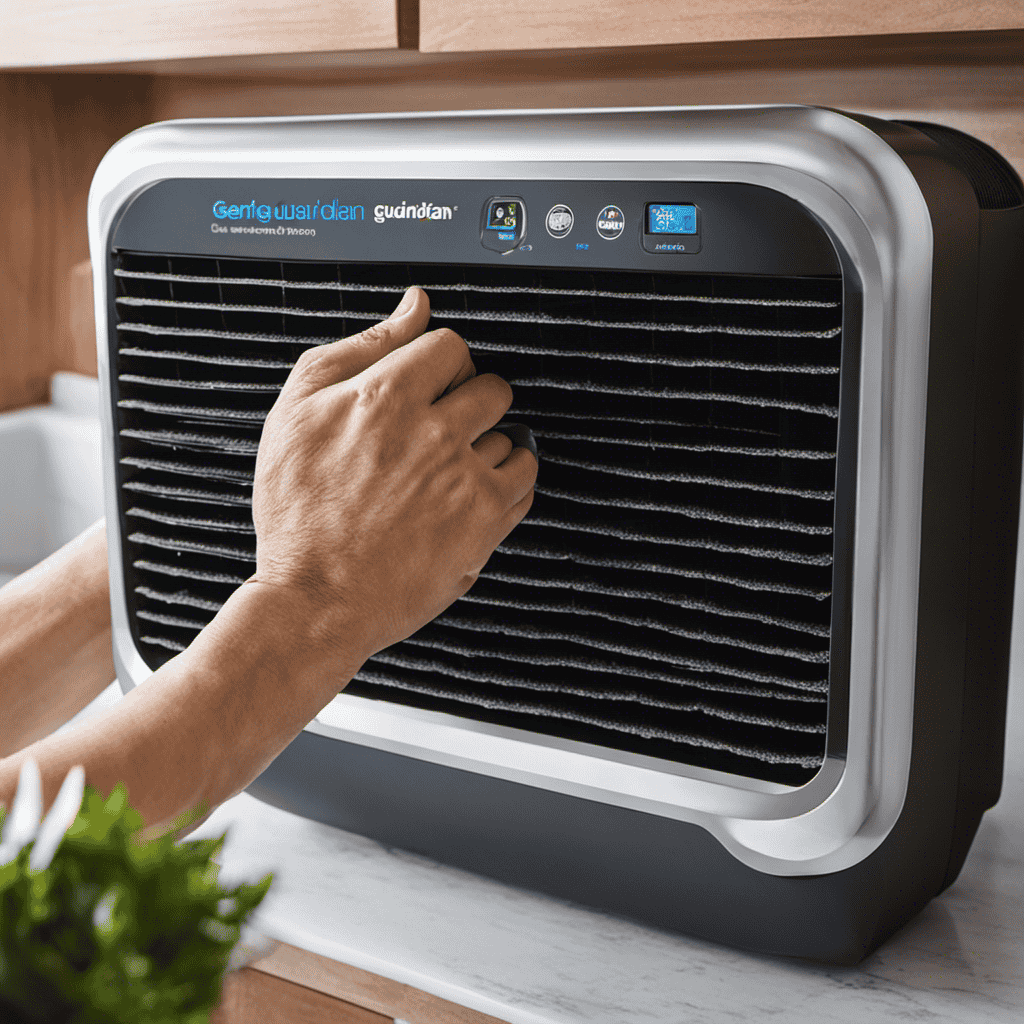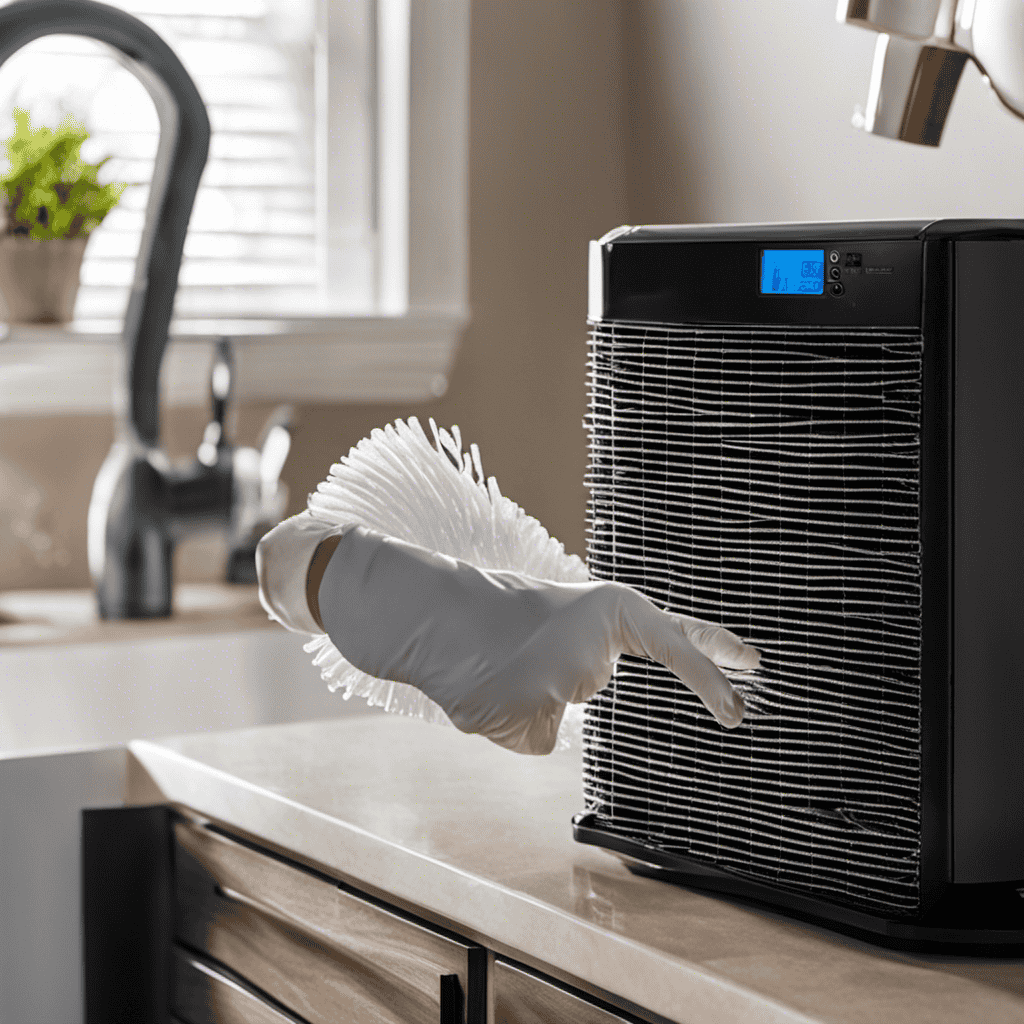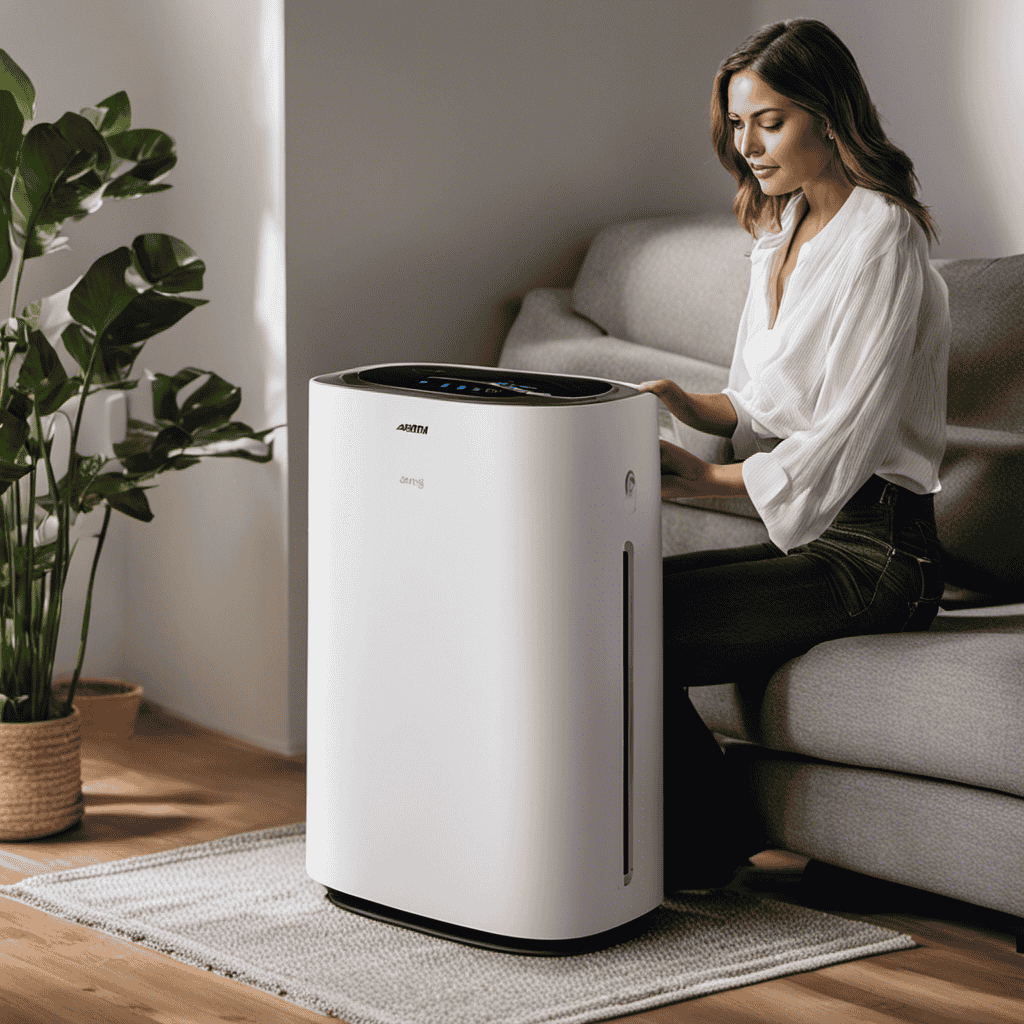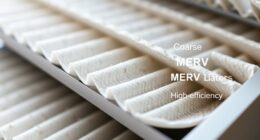As someone passionate about air quality, I frequently catch myself contemplating the mechanics behind the filters in air purifiers. So, what are these filters actually composed of?
In this article, we will delve into the composition of air purifier filters and uncover the secrets behind their efficiency.
From activated carbon to HEPA filters, pre-filters to zeolite, we will explore the different materials that make up these crucial components.
Get ready to embark on a journey of knowledge as we unravel the mysteries of air purifier filters.
Key Takeaways
- Air purifier filters are made of various materials, including activated carbon, HEPA filters, fiberglass, and zeolite.
- The combination of fiberglass and activated carbon in HEPA filters allows for highly efficient air purification.
- Pre-filters, such as mesh pre-filters and carbon pre-filters, play a crucial role in capturing larger particles and removing odors and gases.
- Additional filter technologies, such as electrostatic filters, ionizer filters, antimicrobial coatings, and UV-C light, offer different ways to trap and remove particles and microorganisms from the air.
The Role of Activated Carbon in Air Purifier Filters
Activated carbon is one of the most effective air purifier filter materials. It is used to trap and remove harmful gases and odors. The unique porous structure of activated carbon allows it to adsorb a wide range of pollutants, including volatile organic compounds (VOCs), formaldehyde, benzene, and other harmful chemicals. This is due to its high surface area and the presence of small pores that can capture and hold these contaminants. Activated carbon works through a process called adsorption, where the pollutants are attracted to the surface of the carbon and then trapped within its pores. This makes it an essential component in air purifiers, as it helps improve indoor air quality by reducing the presence of harmful gases and odors.
Understanding the role of activated carbon in air purifier filters is crucial when evaluating their effectiveness in removing pollutants from the air.
Now, let’s delve into the composition of HEPA filters and their importance in air purification.
Understanding HEPA Filters and Their Composition
When it comes to air purifiers, one of the most important components is the HEPA filter. HEPA stands for High Efficiency Particulate Air, and these filters are designed to capture particles as small as 0.3 microns.
The filter itself is made up of a dense mat of fibers that create a barrier, trapping particles and preventing them from recirculating into the air.
HEPA Filter Components
The HEPA filter is made of a dense layer of fiberglass and activated carbon. This combination of materials allows for highly efficient air purification.
The fiberglass layer consists of randomly arranged fibers, which create a dense network of tiny passages. These passages trap and remove particles as small as 0.3 microns, including allergens, dust, and pet dander.
The activated carbon, on the other hand, is effective in removing odors, gases, and volatile organic compounds (VOCs) from the air. It works by adsorbing these pollutants onto its porous surface.
The HEPA filter materials and air purification technology work together to ensure clean and breathable air in indoor environments.
Now, let’s delve into the breakdown of these filter materials in more detail.
Filter Material Breakdown
The combination of fiberglass and activated carbon allows for highly efficient air purification. Fiberglass filters are commonly used in air purifiers due to their high efficiency in capturing large particles like dust and pollen. These filters consist of layers of fine fibers that create a barrier, trapping particles as air passes through.
On the other hand, activated carbon filters are effective at removing odors, gases, and volatile organic compounds (VOCs) from the air. The activated carbon has a large surface area that adsorbs these contaminants, improving the overall air quality.
Therefore, combining fiberglass and activated carbon in air purifier filters provides a comprehensive solution for capturing both large particles and odor-causing substances. This ensures that the air we breathe is clean and fresh.
The Importance of Pre-Filters in Air Purifiers
When it comes to air purifiers, pre-filters play a crucial role in improving the overall effectiveness of the device.
These filters are designed to capture larger particles such as dust, pet hair, and pollen, preventing them from clogging the main HEPA filter.
Regular maintenance of pre-filters is essential to ensure optimal performance and prolong the lifespan of the air purifier.
Pre-Filter Effectiveness
You’ll notice an improvement in the effectiveness of the pre-filter as it captures larger particles like dust and pet hair.
Different pre-filter types offer varying benefits:
- Mesh pre-filters: These have small holes that trap large particles effectively.
- Carbon pre-filters: They not only capture large particles but also remove odors and gases.
- Electrostatic pre-filters: These use an electric charge to attract particles, enhancing their capture.
Studies have shown that pre-filters can significantly reduce the load on the main filter, prolonging its lifespan and improving overall air purification efficiency. By capturing larger particles, pre-filters prevent them from clogging the main filter, allowing it to focus on removing smaller, more harmful particles like allergens and pollutants. This means that your air purifier can perform optimally for longer periods without the need for frequent filter replacements.
Now that you understand the importance and effectiveness of pre-filters, let’s move on to discussing the maintenance required for these filters.
Maintenance for Pre-Filters?
Now that we’ve covered the benefits of pre-filters, let’s talk about how to maintain them. Proper maintenance is crucial to ensure the effectiveness and longevity of your pre-filters.
Regular cleaning is necessary to remove accumulated dust, dirt, and other particles that can clog the filter and hinder its performance. Here are some important steps to follow for pre-filter maintenance:
- Remove the pre-filter from the air purifier.
- Gently tap or shake the pre-filter to remove loose debris.
- Use a vacuum cleaner with a brush attachment to remove embedded dirt and dust.
- If the pre-filter is washable, rinse it with water and mild soap. Allow it to air dry completely before reinstalling.
- If the pre-filter is not washable, replace it with a new one according to the manufacturer’s instructions.
Regular cleaning and replacement of pre-filters will ensure that your air purifier continues to provide clean and healthy air.
Exploring the Use of Zeolite in Air Purifier Filters
Zeolite is commonly used in air purifier filters to absorb odors and harmful substances. This natural mineral is highly effective in trapping and neutralizing various pollutants, making it an essential component of air purification systems.
Here are some key benefits and evidence-based facts about zeolite in air purifier filters:
-
Zeolite has a unique porous structure that allows it to effectively capture and trap a wide range of harmful substances, including volatile organic compounds (VOCs), allergens, and odors.
-
It has been scientifically proven that zeolite can remove up to 90% of certain pollutants, such as formaldehyde and ammonia, from indoor air.
-
Zeolite also has the ability to absorb and release moisture, helping to maintain optimal humidity levels in the room.
-
Unlike some other air purifier filter materials, zeolite is natural, non-toxic, and environmentally friendly.
-
The use of zeolite in air purifier filters has been widely recognized and recommended by experts in the field of indoor air quality.
The Benefits of Electrostatic Filters in Air Purifiers
To enhance the performance of your air purification system, consider using electrostatic filters as they effectively capture and remove airborne particles. Electrostatic filters are designed to attract and trap particles through the use of static electricity. These filters have a high efficiency in capturing even the smallest particles, such as dust, pollen, and pet dander.
Maintenance of electrostatic filters is relatively simple. Regular cleaning is essential to maintain their efficiency. The accumulated particles can be easily removed by washing the filters with soap and water. It is important to let the filters dry completely before reinserting them into the air purifier. Additionally, some electrostatic filters are reusable and can be simply washed and reused, reducing waste and saving money in the long run.
Here is a table summarizing the key points about electrostatic filters:
| Electrostatic Filter Efficiency | Electrostatic Filter Maintenance |
|---|---|
| High efficiency in capturing airborne particles | Regular cleaning with soap and water |
| Can capture even the smallest particles | Let the filters dry completely before reinserting |
| Reusable and cost-effective | Some filters can be washed and reused |
Overall, electrostatic filters are a great option to consider for your air purifier system due to their high efficiency in capturing airborne particles and their easy maintenance.
How Ionizer Filters Work in Air Purifiers
Ionizer filters, also known as negative ion generators, work by emitting negatively charged ions into the air, which attach to positively charged particles, causing them to become too heavy to remain airborne and eventually settle. This technology has been found to be effective in improving indoor air quality by reducing the concentration of airborne pollutants.
Here are some key points to understand about ionizer filter technology:
- Ionizers use electrical charges to generate negative ions, which are released into the air.
- These negative ions attach to airborne particles such as dust, pollen, and pet dander.
- Once attached, the particles become heavier and are less likely to be inhaled.
- Ionizer filters are particularly effective in removing ultrafine particles that can be harmful to human health.
- They can also help neutralize odors and eliminate harmful bacteria and viruses.
The Significance of Antimicrobial Coatings in Air Purifier Filters
When it comes to air purifier filters, there are several key points that deserve our attention: enhanced germ protection, prolonged filter lifespan, and improved air quality.
Antimicrobial coatings play a crucial role in achieving these benefits. By inhibiting the growth of bacteria and other harmful microorganisms, these coatings ensure that the filter remains effective for a longer period of time, while also helping to maintain a cleaner and healthier indoor environment.
Enhanced Germ Protection
You’ll be pleased to know that the enhanced germ protection of the air purifier filter is achieved through advanced filtration technology. The air purifier filter is made up of several layers of materials that work together to effectively eliminate germs and improve air quality.
Here are the key components of the enhanced germ protection:
-
HEPA Filter: This high-efficiency particulate air (HEPA) filter is designed to capture airborne particles as small as 0.3 microns, including germs, bacteria, and viruses.
-
Activated Carbon Filter: This filter is effective in removing odors and harmful gases from the air, providing an added layer of protection against germs.
-
UV-C Light: Some air purifier filters incorporate ultraviolet (UV) light technology to kill germs and disinfect the air. UV-C light has been shown to be effective in eliminating bacteria and viruses.
Prolonged Filter Lifespan
To prolong the lifespan of your air purifier, regularly clean and replace the filters according to the manufacturer’s recommendations. Proper filter maintenance is crucial for ensuring the optimal performance of your air purifier and improving the quality of the air you breathe.
Filters play a vital role in trapping and removing various airborne particles such as dust, pollen, pet dander, and mold spores. Over time, these particles accumulate on the filter, reducing its efficiency and potentially causing the air purifier to work harder.
Improved Air Quality
Regularly cleaning or replacing the filters in your air purifier can significantly enhance the quality of the air you breathe. Here are some benefits of clean air and how it can improve indoor air quality:
-
Reduces Allergens: Clean air filters capture dust, pollen, pet dander, and other allergens, reducing the risk of allergies and asthma.
-
Removes Odors: Air purifier filters can eliminate unpleasant smells like smoke, cooking odors, and pet odors, making your home more pleasant.
-
Decreases Airborne Germs: Clean air filters can trap bacteria and viruses, reducing the spread of illnesses.
Improving indoor air quality has numerous benefits, including better respiratory health, improved sleep, and increased overall well-being. By regularly cleaning or replacing your air purifier filters, you can enjoy cleaner air and all these advantages.
Now, let’s discuss the role of UV-C light in air purifier filters and how it can further enhance air purification.
The Role of UV-C Light in Air Purifier Filters
When considering air purifier filters, it’s important to understand the role of UV-C light in eliminating airborne contaminants.
UV-C light, a type of ultraviolet light with a wavelength between 200 and 280 nanometers, has been shown to be effective in destroying microorganisms such as bacteria, viruses, and mold spores. This is achieved by damaging the DNA or RNA of these harmful particles, rendering them unable to reproduce and causing their death.
However, it’s crucial to note that while UV-C light can be highly effective in disinfection, it must be used with caution. Direct exposure to UV-C light can be harmful to humans and can cause skin burns and eye damage. Therefore, air purifier filters that incorporate UV-C light should have proper safety measures in place to prevent any harm to individuals.
Now, let’s explore the efficiency of fiberglass filters in air purifiers.
Exploring the Efficiency of Fiberglass Filters in Air Purifiers
You’ll find that fiberglass filters are commonly used in air purifiers due to their high efficiency in capturing small particles and allergens.
- Fiberglass filters are made from interwoven glass fibers, creating a dense mat that effectively traps airborne particles.
- The efficiency of fiberglass filters is measured by their Minimum Efficiency Reporting Value (MERV) rating, which ranges from 1 to 20.
- Fiberglass filters with higher MERV ratings have finer fibers, allowing them to capture smaller particles.
The benefits of using fiberglass filters in air purifiers are numerous.
- They are cost-effective and widely available, making them a popular choice for both residential and commercial use.
- Fiberglass filters have a high dust-holding capacity, meaning they can capture and hold a significant amount of debris before needing to be replaced.
- They are also effective in capturing common allergens like pollen, pet dander, and mold spores, improving indoor air quality and reducing allergy symptoms.
Understanding the Composition of Polyester Filters in Air Purifiers
To understand the composition of polyester filters, take note that they are constructed from synthetic fibers that form a dense barrier against airborne particles.
Polyester filters are made from a type of plastic called polyethylene terephthalate (PET). This material is known for its durability and resistance to moisture, making it an ideal choice for air purifiers.
The synthetic fibers in polyester filters are tightly woven together, creating a dense mesh that effectively traps and removes particles from the air. One of the benefits of polyester filters is their high efficiency in capturing small particles, such as pollen, dust, and pet dander.
Additionally, polyester filters are easy to maintain. They can be cleaned by vacuuming or rinsing with water, and they have a longer lifespan compared to other filter types. Regular maintenance ensures optimal performance and prolongs the life of the filter.
The Pros and Cons of Paper Filters in Air Purifiers
Paper filters, also known as cellulose filters, offer a cost-effective option for air purification. However, they do have the drawback of needing frequent replacement. Despite this drawback, there are several advantages to using paper filters in air purifiers.
-
High Efficiency: Paper filters are designed to capture a wide range of airborne particles, including dust, pollen, pet dander, and mold spores. They can efficiently remove these pollutants from the air, improving indoor air quality.
-
Easy to Install: Paper filters are generally easy to install in air purifiers. They often come with clear instructions, allowing users to replace them without any hassle.
-
Affordable: Compared to other types of air filters, paper filters are typically more affordable. This makes them a popular choice for individuals on a budget or those who need to replace filters frequently.
However, there are also some downsides to using paper filters.
-
Limited Lifespan: Paper filters have a shorter lifespan compared to other filter types. They need to be replaced more frequently, resulting in increased maintenance costs.
-
Limited Filtration Capacity: While paper filters are effective at capturing larger particles, they may not be as efficient in capturing smaller particles, such as bacteria and viruses.
-
Prone to Mold Growth: Paper filters can provide a suitable environment for mold growth if they become damp or wet. This can release harmful mold spores into the air, potentially worsening indoor air quality.
Overall, paper filters offer a cost-effective solution for air purification. However, their frequent replacement and limitations in filtration capacity should be considered.
Frequently Asked Questions
Are Air Purifier Filters Recyclable?
Air purifier filters are made of various materials, such as activated carbon and HEPA filters. Recycling options for air purifier filters vary, but some manufacturers offer take-back programs. Eco-friendly alternatives include reusable filters and filterless air purifiers.
How Often Should Air Purifier Filters Be Replaced?
Air purifier filters should be replaced every 6-12 months, depending on usage. Regular replacement ensures optimal performance and clean air. For example, in my home, I replaced the filter every 9 months and noticed improved air quality.
Can Air Purifier Filters Remove Odors?
Yes, air purifier filters can remove odors. Regular air purifier filter maintenance is crucial for optimal performance. Using air purifier filters offers many benefits, including eliminating odors and improving air quality.
Do Air Purifier Filters Remove Allergens?
Yes, air purifier filters can remove allergens. They help with asthma by capturing particles like pollen, dust mites, and mold spores. Additionally, they can effectively remove pet dander, making the air cleaner and reducing allergic reactions.
Can Air Purifier Filters Trap Bacteria and Viruses?
Air purifier filters are effective in trapping bacteria and viruses. Regular maintenance, such as replacing the filter according to the manufacturer’s instructions, ensures optimal performance. A clean filter is vital for maintaining clean and healthy indoor air.
Conclusion
In conclusion, the composition of air purifier filters is a fascinating blend of various materials that work together to create cleaner and fresher air.
From the powerful activated carbon that absorbs odors and chemicals, to the efficient HEPA filters that trap microscopic particles, each component plays a vital role.
The pre-filters, zeolite, electrostatic filters, UV-C light, fiberglass, polyester, and even paper filters all contribute to the overall effectiveness of the air purifier.
Imagine a symphony of materials working harmoniously to purify the air we breathe, ensuring a healthier and safer environment for us all.
